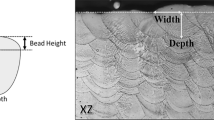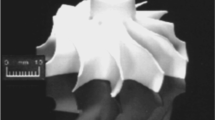Abstract
A 25-μm-thick ceramic slurry-coated 12 ppi (pores per linear inch) polyurethane foam suitable for synthesis of oxide-bonded reticulated porous SiC ceramics was analysed by the thermal analysis techniques (thermogravimetry and differential thermal analysis) up to 700 °C in air to investigate the polymer degradation reactions associated with the pyrolysis stage of the fabrication process. The kinetic parameters of the polymer degradation reactions were determined using the non-isothermal thermogravimetric data, and the degradation mechanism was evaluated. The effects of slurry coating on the foam degradation process were discussed, and slurry coating on foam was found to have insignificant effects on PUF degradation reactions.






Similar content being viewed by others
References
Aubrey LS, Schmahl R. Application of reticulated silicon carbide foam filters for iron casting applications. Foundry Trade J. 1991;165:769–73.
Bao S. Filtration of aluminium—experiments, wetting and modelling. Ph. D. Thesis, Norwegian University of Science and Technology, Trondheim, Norway, 2011.
Adler J. Ceramic diesel particulate filters. Int J Appl Ceram Technol. 2005;2:429–39.
Nguyen P, Pham C. Innovative porous SiC-based materials: from nanoscopic understanding to tunable carriers serving catalytic needs. Appl Catal A. 2011;391:443–54.
Liu H, Li S, Zhang S, Chen L, Zhou G, Wang J, Wang X. Catalytic performance of monolithic foam Ni/SiC catalyst in carbon dioxide reforming of methane to synthesis gas. Catal Lett. 2008;120:111–5.
Rodriguez P, Meille V, Pallier S, Sawah MAA. Deposition and characterization of TiO2 coatings on various supports for structured (photo) catalytic reactors. Appl Catal A. 2009;360:154–62.
Masson R, Keller V, Keller N. β-SiC alveolar foam as a structured photocatalytic support for the gas phase photocatalytic degradation of methylethylketone. Appl Catal B Environ. 2015;170:301–11.
Kouame NA, Robert D, Keller V, Keller N, Pham C, Nguyen P. Preliminary study of the use of β-SiC foam as a photocatalytic support for water treatment. Catal Today. 2011;161:3–7.
Xing H, Cao X, Hu W, Zhao V, Zhang J. Interfacial reactions in 3D-SiC network reinforced Cu-matrix composites prepared by squeeze casting. Mater Lett. 2005;59:1563–6.
Muthukumar P. Development of porous radiant burners for domestic LPG cooking and industrial applications. J Pet Environ Biotechnol. 2014;5:52.
Brown DD, Green DJ. Investigation of strut crack formation in open cell alumina ceramics. J Am Ceram Soc. 1994;77:1467–72.
Dey A, Kayal N, Chakarbarti OP, Caldato RF, André CM, Innocentini MDM, Guerra VG. Studies on permeability properties and particle capture efficiencies of porous SiC ceramics processed by oxide bonding technique. J Porous Media. 2015;18:861–72.
Vlaev L, Nedelchev N, Gyurova K, Zagorcheva MA. A comparative study of non-isothermal kinetics of decomposition of calcium oxalate monohydrate. J Anal Appl Pyrolysis. 2008;81:253–62.
Georgieva V, Zvezdova D, Vlaev L. Non-Isothermal kinetics of thermal degradation of chitin. J Therm Anal Calorim. 2013;111:763–71.
Maity A, Das H, Kalita D, Kayal N, Goswami T, Chakrabarti OP. Studies on formation and siliconization of carbon template of coir fibreboard precursor to SiC ceramics. J Eur Ceram Soc. 2014;34:3499–511.
Coats AW, Redfern JP. Kinetic parameters from thermogravimetric data. Nature. 1964;201:68–9.
Rein G, Lautenberger C, Fernandez-Pello AC, Torero JL, Urban DL. Application of genetic algorithms and thermogravimetry to determine kinetics of polyurethane foam in smoldering combustion. Combust Flame. 2006;146:95–108.
Ravey M, Pearce EM. Flexible polyurethane foam. I. Thermal decomposition of a polyether based water blown commercial type of flexible polyurethane foam. J Appl Polym Sci. 1997;63:47–74.
Font R, Fullana A, Caballero JA, Candela J, Garica A. Pyrolysis study of polyurethane. J Anal Appl Pyrolysis. 2001;58–59:63–77.
Auerbach I. Evaluation of kinetic parameters approximate for modeling urethane foam insulation performance. J Therm Anal Calorim. 1989;35:1629–41.
Bar-Ilam A, Putzeys OM, Rein G, Fernandez-Pello AC, Urban DL. Transition from forward smoldering to flaming in small polyurethane foam samples. Proc Combust Inst. 2005;30:2327–34.
Chao CYH, Wang JH. Comparison of thermal decomposition behavior of a non-fire retarded and a fire-retarded flexible polyurethane foam with phosphorous and brominated additives. J Fire Sci. 2001;19:137–56.
Acknowledgements
One of the authors (KVV) acknowledges with thanks the summer internship provided to him by CSIR-CGCRI, Kolkata, India, under the 12 Five-Year Plan Project “Advanced Ceramic Materials and Components for Energy and Structural Applications (CERMESA) - ESC0104”.
Author information
Authors and Affiliations
Corresponding author
Appendix
Appendix
Determination of loss in mass in slurry-coated PUF sample
Let X sp is the initial mass of the slurry-coated PUF sample (in mg), F sp is the final mass retention (in %), and t sp is the mass retention (in %) at any time t. Let for the ceramic powder obtained by drying the slurry, the corresponding figures are X s , F s and t s.
Let us suppose that the entire sample of the slurry-coated PUF contains only slurry. In this case,
Thus, the degree of conversion for PUF in the slurry-coated PUF at time t or,
Rights and permissions
About this article
Cite this article
Dey, A., Biswas, P., Veerapandiyan, V.K. et al. Thermal degradation of ceramic slurry-coated polyurethane foam used in making reticulated porous SiC ceramics. J Therm Anal Calorim 131, 2603–2610 (2018). https://doi.org/10.1007/s10973-017-6863-6
Received:
Accepted:
Published:
Issue Date:
DOI: https://doi.org/10.1007/s10973-017-6863-6




